|
Introduction
However much mankind attempts to solve the mystery of why the
pyramids were constructed, the darkness in which it is wrapped will
be impenetrable to the uninitiated eye. And that is how it will
remain until the mature gaze, contemplating the ruins of a lost
civilization, sees the world in the same way as it was seen by the
ancient Hierophants. At that point, liberated, it will acknowledge
the reality of what mankind still rejects, of what was for the
Hierophants not a myth, not an abstract religious view of the world,
but a guide for action.
Go Back
What are the Wands of Horus?
Their roots go back into the depths of time. For the priests and
pharaohs of Ancient Egypt the Wands of Horus — metal cylinders
filled with various special materials — were a tool for
“attainment”, allowing them to achieve a step by step evolution of
their psychic, energy and, consequently, physical capacities, the
development of which was a decisive factor in preparing to enter
into “intercourse with the gods” through the pyramids.
 If certain conditions are observed and sessions conducted on a
regular daily basis, the Wands of Horus can not only correct, but
also stimulate a person’s nervous, energy and immune systems,
creating the preconditions for their improvement
(1). This requires
work founded on a precise understanding of what the Wands of Horus
are and the principle by which they work, a knowledge of the cycles
of activeness in the human energy system and a number of elements
making up a complex approach, an essential part of which is
interaction with natural sources of energy, such as trees, rivers,
lakes, the sea and mountains. If certain conditions are observed and sessions conducted on a
regular daily basis, the Wands of Horus can not only correct, but
also stimulate a person’s nervous, energy and immune systems,
creating the preconditions for their improvement
(1). This requires
work founded on a precise understanding of what the Wands of Horus
are and the principle by which they work, a knowledge of the cycles
of activeness in the human energy system and a number of elements
making up a complex approach, an essential part of which is
interaction with natural sources of energy, such as trees, rivers,
lakes, the sea and mountains.
The Wands of Horus are also a means of prevention and treatment,
providing the opportunity in certain disorders to correct particular
deviations from the norm and noticeably improve a person’s state of
health, since they inspire very deep-running physiological and
energetic processes.
It is important to stress that the knowledge of the Ancient
Egyptians was founded not on mystic, astrological or esoteric
(2)
doctrines, but on a strict grasp of the principles on which the
universe is founded. In other words, at the basis of the theoretical
and spiritual constructs of the Ancient Egyptian initiates lay first
and foremost Knowledge and not faith.
The Wands of Horus and, indeed, the knowledge of the Ancients in
general is a very interesting and wide-reaching topic. Therefore, in
order to help readers to grasp the structure of principles invisible
to the uninitiated eye and to draw closer to the sources of
knowledge, the International Information Centre for UFO Research
presents a publication intended to bring to a wider public recent
results obtained from the study of the legacy of Ancient Egypt.
This brochure is the first work to shed some light on the mystery of
why the pyramid complex at Giza in Egypt was constructed. Reading it
you will find out not only about the principles that lay behind the
idea of constructing the pyramids, but also about the connection
between the Wands of Horus and the “Energy Source” located within
the pyramid. It is that connection that gives the Wands of Horus
their miraculous properties and their harmonizing effect on a
person’s energy system and, as a consequence, on his or her general
state of health.
One of the sections is devoted to a description of the technology
used to produce the Wands of Horus and the mechanism by which they
operate. This will help the reader to understand how they are
constructed, and how the pyramids and the cylinders work in a single
complex, down to the finest details.
You will learn some results of experiments conducted by Russian
scientists to study the effect of the Wands of Horus on the human
organism and the effect of
the Pyramid on animate and inanimate
objects.
Go Back
A Secret Recovered
Every time we return again to this world, we do not recall the past
and, discovering the world anew, we live out our lives, leaving a
track which we shall probably not remember when we come back again.
Incarnation after incarnation we move through the dark labyrinths of
life, almost by touch alone, trying to discover the sacred meaning
of that which has been covered over by the sands of history, trying
to read the invisible message left us by past civilizations. But,
inhabiting a different body, in a different age that imposes its new
rhythm upon us, and basing ourselves on other values than those that
 prevailed thousands of years ago, we look into ourselves with
detachment in search of an answer to that which we did not
comprehend in other lives. prevailed thousands of years ago, we look into ourselves with
detachment in search of an answer to that which we did not
comprehend in other lives.
The gradual recovery of knowledge that was the property of previous
civilizations, that to one extent or another determined the fate of
peoples and the distinctive character of different ages, is a
non-accidental characteristic of our own era, playing an important
role in the process by which the material of human awareness is
perfected.
Knowledge — that most cherished of human goals — has at the same
time been the cause of many troubles, especially when the level of
morals and ethics was lower than that of knowledge. It is for that
very reason that when knowledge was capable of becoming the cause of
misfortunes, of those catastrophic processes which humans lacked the
ability to control,
events took place that removed that knowledge. As a consequence we
today, so highly advanced as some believe, do not know what those
who lived in the distant past knew.
Until now the prevailing current of opinion has been that profound
knowledge could not have existed in the distant past on principle,
because the emergence of scientific knowledge proceeds from the
simple to the complex. It follows that mankind has not yet reached
the peak of its intellectual ability. There is, however, a mass of
puzzles thrown up by the study of the architectural monuments and
writings of the distant past that forces us to think again about the
level of knowledge the Ancients really possessed
(3).In particular
we are still challenged by the question of what the pyramids are,
still trying to grasp their true purpose and the reasons for their
appearance.
Pyramids, which have long troubled human imagination, were
constructed in various parts of the globe, forming systems of their
own, but we shall begin our account with an examination of the
immense complex of the Great Pyramids located outside Giza in Egypt.
Of itself the pyramid, its shape and configuration, is an extremely
strange structure, while the curious phenomena that have been
observed in the chambers of the pyramids suggest that some kind of
energy processes are taking place there. Today our task is to try to
understand the principles lying behind those processes.
You have probably already heard that there are certain places within
the pyramid where foodstuffs of biological origin will
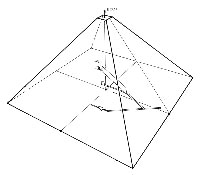 keep for an
indefinite length of time. There are also chambers where, if someone
remains for an extended period, they experience an incredible sense
of disquiet.
However, there are also areas which engender feelings of a different
kind: positive, stimulating creative activity, and fostering
intuition. keep for an
indefinite length of time. There are also chambers where, if someone
remains for an extended period, they experience an incredible sense
of disquiet.
However, there are also areas which engender feelings of a different
kind: positive, stimulating creative activity, and fostering
intuition.
If we look at the problem of the pyramid from the viewpoint of the
simple,
visually clear science of geometry, it turns out that we can come
closer to an
understanding of the object through describing it in a very simple
manner.
Suffice it to recall that in ancient times the laws of geometry were
studied in
very great depth and particular attention was devoted to the
triangle with
sides in the ratio 3:4:5.
Today we are well aware that the hypotenuse of such a triangle is a
fundamental concept relating directly to the question of harmony.
And anything we say about harmony is associated first and foremost
with sound.
Sound is what human beings are immediately attuned to, irrespective
of their cultural background, level of education or intelligence.
In this context there are a number of curious facts that need to be
pointed out. One is that when a baby comes into the world its first
cry, no matter what its timbre or volume, has as a rule the
frequency of
A. Another is that those people who have “perfect pitch” relate
other notes back to A. The sound of A is then a kind of yardstick
frequency.
It is also known that the average distance between the human
eardrums is an exact fraction of the wavelength of A. The wavelength
of A is 78 centimeters. Divide that by four and you get the distance
in question.
(4).
We also know that frequencies are only resonant when the one
wavelength is an exact multiple of the other. That means that nature
has constructed the human hearing apparatus is such a way that it is
tuned to the frequency of A, which plays a prime role in the musical
scale.

A graphic depiction of the principle of resonance
The pyramid is interesting for the fact that its shape contains not
vertical planes as in ordinary architecture, but inclined ones
instead. Therefore if you make a cross-section of a pyramid, you get
a triangle, or two right-angled triangles back to back. And since
you have a right-angled triangle, then you will recognize the
position of the hypotenuse.
What is the hypotenuse, though?
In respect of a function or phenomenon the hypotenuse expresses the
rate of a process
(5), that is to say the frequency (which is
characteristic for vibratory processes).
The pyramids pose a host of puzzles, one of which is why they were
built. We were taught to regard them as the tombs of pharaohs, but
still today the actual burial-place has not been discovered in a
single pyramid. It is just not there. The question then arises: for
what purpose were such gigantic constructions put up, if not to
glorify the pharaoh as God’s representative on Earth?
Not so long ago, Japanese researchers tried to build a pyramid only
11 meters tall, using the construction methods employed (according
to Herodotus) in Ancient Egypt a few thousand years ago, and they
were unable to bring the four faces of the pyramid together to a
single point.
(6). The height of the tallest pyramid at Giza is 146
meters, yet it comes to a point. That naturally prompts the
question: why build in this manner, if it is so difficult and
laborious?
In order to answer that question we should begin with an examination
of the principles lying behind the idea of constructing the
pyramids.
The key to understanding the laws that formed the basis for the
construction of the pyramids is provided by the tablets on which,
according to legend, the Ancient Egyptians expounded their
knowledge.

At the beginning of the century
Quibell’s expedition to Saqqara discovered the tomb of an Ancient
Egyptian architect from which they extracted a set of wooden boards
covered in carving.
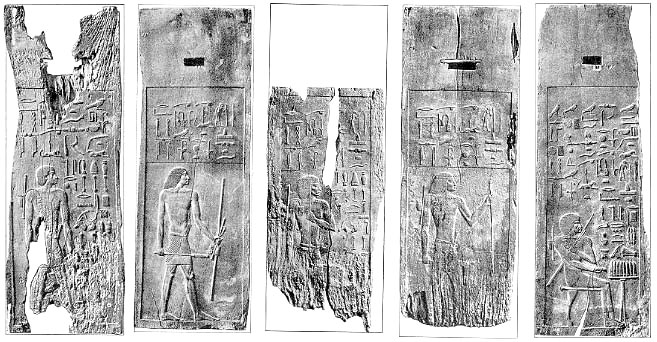
Judging by the number of niches in which the panels stood,
there were originally eleven of them
(7) . The order in which the
panels were placed in the tomb of Hesi-Ra follows what is known as
the Lucas sequence.
(8) . They are the figures obtained from adding
and subtracting the
ordinal numbers that form the Golden Section sequence. The images
presented on the panels follow the same pulsating rhythm or, as the
Ancient Egyptians themselves said, the KA–BA rhythm.
In the Ancient Egyptian dualistic conceptual system, BA
(9) refers
to the real, physical object or person; KA is what makes up our
energy shell. From the state of the KA it is possible to determine
precisely the psychological and physical condition of the person,
which organs are damaged, and so on. In short, it is a particular
energetic-informational structure in which everything is reflected.
The panels in question have proved to be something unique. Several
layers of information can be traced on them, providing the key to
recognition of the fact that the Ancient Egyptians knew all about
the Golden Section long before Pythagoras.
Today we know from measurements that have been taken that the
principle of the Golden Section was used in the construction of all
the great pyramids.
Another question arises. It is not easy to produce a structure like
a pyramid, you need to have the appropriate constructional
 technology suited to the purpose, but beyond that its geometrical
structure incorporates the irrational ratios of the Golden Section,
which are more difficult than ordinary whole numbers. Why? technology suited to the purpose, but beyond that its geometrical
structure incorporates the irrational ratios of the Golden Section,
which are more difficult than ordinary whole numbers. Why?
It should be pointed out that the whole musical scale, the whole
sonic temperament, obeys the same law of the Golden Section.
Remember what it says in the Gospel: “In the beginning was the Word”
— and the word is sound (a wave process characterized by frequency).
And if the word conveys meaning, then that means that the frequency,
as a characteristic of the energy process should also have some kind
of meaning. The one cannot exist without the other. That is a
principle.
The conclusion follows that the principle of the Golden
Section, upon which the great multitude of objects in the biological
world are constructed, bears a very profound, fundamental meaning.
And it is no coincidence that in the human being in particular the
law of the Golden Section can be traced in some many different
variations that one can only wonder that nature created us just that
way.
The bones of the fingers, three in number; three parts of the
arm (the relationship of lengths) — elements of the Golden Section.
The heart beats in this rhythm and pushes blood into the aorta,
leaving a portion in the ventricle. All of it the Golden Section.
The rods and cones of the eye, the cochlea of the ear (the ratio of
the lengths of the spirals), the structure of the whole skeletal
framework — examine the statistical averages and it is all the
Golden Section. Even the dynamics of the neural structures in
certain mental states obey the same law.
Can that really be mere chance or a peculiarity of mankind alone?
No, the same principle governs the orbital periods of the planets in
the Solar System, the musical scale is founded on it, the system of
chemical elements and indeed everything connected with natural
systems obeys that law.
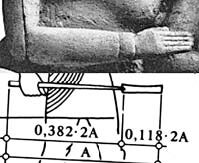 The
wands held in the left hand of the priest who is depicted on the
first main panel are shown in a ratio connected with the frequency
of A. The standard value accepted for the pitch of A today is 440
Hz, but 441 Hz is more precise. It is astonishing that no-one
particularly noticed that if you place the figures 441 after a
decimal point, i.e. 0.441, what you get is a function of the Golden
Section. The
wands held in the left hand of the priest who is depicted on the
first main panel are shown in a ratio connected with the frequency
of A. The standard value accepted for the pitch of A today is 440
Hz, but 441 Hz is more precise. It is astonishing that no-one
particularly noticed that if you place the figures 441 after a
decimal point, i.e. 0.441, what you get is a function of the Golden
Section.
Knowing all that, we arrive at an interesting revelation. Not only
do these panels explain the principle of using the Golden Section,
they also present tools that are elementarily simple, yet work like
a computer. Our arms themselves are already tools of the same kind
as the “measuring instrument” depicted on the tablets. Calculations
have shown that this wand is a tool with which it is possible to
calculate any value of the Golden Section directly as a length,
without using any complicated mathematical formulae, just
manipulating the “magic wand”, adding on and taking away.
You get the feeling that human beings were created to some kind of
standard. It would be more correct, however, to say that human
beings could not have formed differently for the simple reason that
they appeared in an environment that imposes those parameters, and
the values of the Golden Section bear a direct relation to what we
call “harmonic resonance”. (See “Appendix 1”)
 Anything related to resonant phenomena must in the most
general terms be connected with the functions of the Golden
Section. Because nature works in the simplest, most
economical, most effective, most colourful and most diverse
manner — using the Golden Section. Anything related to resonant phenomena must in the most
general terms be connected with the functions of the Golden
Section. Because nature works in the simplest, most
economical, most effective, most colourful and most diverse
manner — using the Golden Section.
Today it is possible to say with complete certainty than the
knowledge encoded on the Hesi-Ra panels formed the basis for the
construction of the pyramids. It represents the missing link that
was needed in order to be able to state that the pyramids were built
on the level of exact science.
It is very important that the ration between the dimensions of the
two rods in the priest’s left hand is such that their product is
0.441, or the frequency of A [divided by a thousand].
The calculation is quite simple. The two rods measure 0.5 and
0.822 [units]. Multiplying those two values, 0.5 x 0.882 =
0.441.
This panel shows a table with what Egyptologists tell us are
sacrificial loaves on it. We have here a priest of Horus. In the
“Sacred Triangle” Horus was characterized by the hypotenuse, the
harmonizing element. To be a priest of Horus meant to be the
Guardian of the Knowledge of Harmony. And harmony is the thing that
embraces absolutely all spheres of activity and knowledge. This
priest (who was also an architect) was the number one person in the
Ancient Egyptian civilization, so important that information about
him was not distributed anywhere. He was a man of mystery. Hesi-Ra
means “Marked Out by the Sun”.
It would seem that what is on the table is not sacrificial loaves
but some sort of tuning device set to the pitch of A. Confirmation
of this is the fact that the distance between the table-top on which
the device stands and the floor is precisely 0.441 of the
corresponding standard
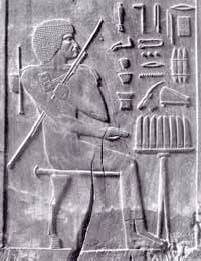 length. The device stands on a base, and that
base is equal to 441. The measuring instruments used by the Ancient
Egyptian architects were set using the tuning device. Hesi-Ra
indicates this directly. length. The device stands on a base, and that
base is equal to 441. The measuring instruments used by the Ancient
Egyptian architects were set using the tuning device. Hesi-Ra
indicates this directly.
Take a close look at the first panel (click
imager right). The priest depicted there
holds two measuring instruments with one hand thus indicating that
they are linked together, while his other, right, hand points to the
tuning device thus emphasizing the link between it and the measuring
instruments. In other words, the measuring instruments are linked to
the musical scale.
It follows that, if measuring rods are harmonized with a tuning
device set to the pitch of A, then to measure with those rods means
to give the space in question resonant qualities founded
on the musical scale. In other words, to introduce a system of
linear-spatial parameters into a system of sonic harmony.
(10) .To
build taking the laws just expounded into account means to create
edifices that interact with the natural world, with its energy
sources through the principle of harmonic resonance, that is through
the mechanisms that lie at the foundation of the universe. Such an
approach in its turn opens up the possibility of interacting with
nature on a fundamentally different level.
Now we turn to a fact that sheds light on one architectural decision
that was founded on the principles expounded above and reveals some
of the details in the pyramid builders’ conception.
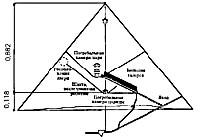 In the
Pyramid of Cheops there is a chamber, erroneously referred to
by the majority of Egyptologists as the “Queen’s burial chamber”,
whose situation in respect of the summit of the pyramid is connected
with the tuning frequency. If we take the height of the whole
pyramid as one unit, and measure down a distance of 0.882 — twice
the frequency of A (or rather an octave higher), we find the chamber
at exactly that point. In the
Pyramid of Cheops there is a chamber, erroneously referred to
by the majority of Egyptologists as the “Queen’s burial chamber”,
whose situation in respect of the summit of the pyramid is connected
with the tuning frequency. If we take the height of the whole
pyramid as one unit, and measure down a distance of 0.882 — twice
the frequency of A (or rather an octave higher), we find the chamber
at exactly that point.
But if we remember that the average human
ear, indeed the whole structure of the human being, is attuned to
the frequency of A, forming a kind of planetary field of this
keynote signal, it emerges that the chamber within the pyramid is
placed at a position attuned to the resonating frequency of that
field.
If, proceeding from that, we accept that
the pyramid works as a
resonator, then we can begin to think of the purpose of pyramid as
taking the form of a special kind of generator. Then the reason for
the appearance of resonance characteristics and energy phenomena at
various points in the pyramid becomes clear.
It follows that the pyramid structure can have what might be termed
a corrective effect on human beings.
Evidently the pyramid was intended to influence human psychological
and physiological structure. And not of just one person, but of a
large number. And the correction of a person’s psychological and
physical qualities is bound up with his ethical standards, with
harmonization, because harmony divorced from ethical principle
simply cannot exist.
Are the pyramids working now?
The pyramids are always working. They cannot fail to work. There is,
however, the question of their activation. The periods when the
pyramids are active and the opportunities that they afford are
connected with energy processes taking place in the universe. While
they are resonators, the pyramids are at the same time antennae of a
kind, a system by which energy and information passes from one space
to another. That, in turn, determines the constant use of the
pyramids to deal with a wide range of tasks.
Go Back
|
 If certain conditions are observed and sessions conducted on a
regular daily basis, the Wands of Horus can not only correct, but
also stimulate a person’s nervous, energy and immune systems,
creating the preconditions for their improvement
If certain conditions are observed and sessions conducted on a
regular daily basis, the Wands of Horus can not only correct, but
also stimulate a person’s nervous, energy and immune systems,
creating the preconditions for their improvement
 prevailed thousands of years ago, we look into ourselves with
detachment in search of an answer to that which we did not
comprehend in other lives.
prevailed thousands of years ago, we look into ourselves with
detachment in search of an answer to that which we did not
comprehend in other lives.  keep for an
indefinite length of time. There are also chambers where, if someone
remains for an extended period, they experience an incredible sense
of disquiet.
However, there are also areas which engender feelings of a different
kind: positive, stimulating creative activity, and fostering
intuition.
keep for an
indefinite length of time. There are also chambers where, if someone
remains for an extended period, they experience an incredible sense
of disquiet.
However, there are also areas which engender feelings of a different
kind: positive, stimulating creative activity, and fostering
intuition. 


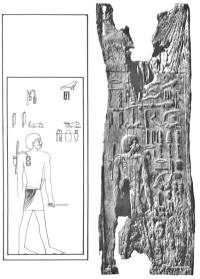
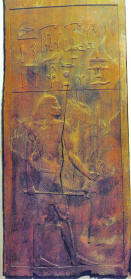
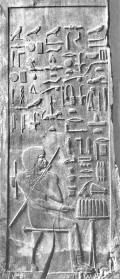
 technology suited to the purpose, but beyond that its geometrical
structure incorporates the irrational ratios of the Golden Section,
which are more difficult than ordinary whole numbers. Why?
technology suited to the purpose, but beyond that its geometrical
structure incorporates the irrational ratios of the Golden Section,
which are more difficult than ordinary whole numbers. Why?  The
wands held in the left hand of the priest who is depicted on the
first main panel are shown in a ratio connected with the frequency
of A. The standard value accepted for the pitch of A today is 440
Hz, but 441 Hz is more precise. It is astonishing that no-one
particularly noticed that if you place the figures 441 after a
decimal point, i.e. 0.441, what you get is a function of the Golden
Section.
The
wands held in the left hand of the priest who is depicted on the
first main panel are shown in a ratio connected with the frequency
of A. The standard value accepted for the pitch of A today is 440
Hz, but 441 Hz is more precise. It is astonishing that no-one
particularly noticed that if you place the figures 441 after a
decimal point, i.e. 0.441, what you get is a function of the Golden
Section. 

 In the
Pyramid of Cheops there is a chamber, erroneously referred to
by the majority of Egyptologists as the “Queen’s burial chamber”,
whose situation in respect of the summit of the pyramid is connected
with the tuning frequency. If we take the height of the whole
pyramid as one unit, and measure down a distance of 0.882 — twice
the frequency of A (or rather an octave higher), we find the chamber
at exactly that point.
In the
Pyramid of Cheops there is a chamber, erroneously referred to
by the majority of Egyptologists as the “Queen’s burial chamber”,
whose situation in respect of the summit of the pyramid is connected
with the tuning frequency. If we take the height of the whole
pyramid as one unit, and measure down a distance of 0.882 — twice
the frequency of A (or rather an octave higher), we find the chamber
at exactly that point.